An “Orange Picker”
Windsor, Ontario’s Evening Record front page for 15 February 1915 had stories about the French forces beating the Germans in the Lorraine Forest; the Kaiser going to Cuxhaven to see off U-Boats in their bid to starve out England; that Ottawa was plunged in darkness due to the a report from Brockville, Ontario that three aeroplanes were seen heading for Ottawa[i], requiring the Chief of Police to order the extinguishing of lights around and at Parliament Hill.
In this heighten atmosphere of war fever and with the newspaper reporting that westerly winds blowing in fair weather resulting in “a little lower temperatures” were expected that day, a “British born subject” entered the recruiting office of the 18th Battalion and enlisted. This 21- and 5-month-old man was an “Orange Picker” and stood 5 feet 7 inches tall and stated that his father, an O.C. Rucker of 1103 East Clay Street of Richmond Virginia as his next-of-kin.
The former claim was unlikely, and the latter claim was a lie.
The problem was “Barrington Ambrose Rucker” was known to his family and friends as Ambrose Rucker, late of Vanderbilt University, Nashville, Tennessee.
His enlistment with the Battalion was just in time. The 18th Battalion, forming in London, Ontario, and recruiting in other cities in towns in South-Western Ontario was off to England not 2-months later. Private Rucker would be serving as a stretcher-bearer with the Battalion under the Battalion Medical Officer, Major George Carlton Hale.
As it turned out, Private Rucker, the orange picker, was actually a medical student, who would have graduated in 1917, if he had continued his education.
To War
After training in England from May to September, the 18th Battalion arrived for active combat duty at Boulogne, France on 15 September 1915 and was initiated to front-line service on 26 September in reserve trenches and then in the front-line the next day. It suffered its first casualties due to enemy action when Private Herbert John Logan was killed at a listening post and Captain Ernest Walter Hallam was shot through the head and died instantly on 29 September 1915.
As Rucker was a stretcher-bearer he was, perhaps, tasked with the retrieval of these bodies, who sadly, would not require treatment and support due to the nature of their wounds. These men dying action, not 3-days after the Battalions introduction to the front-line, was a bitter reminder to the reality and hazards of war.
Wounded
Barely a month-and-a-half would pass as Rucker would serve in this capacity giving aid and succour to the wounded and dying when he was wounded with a bullet to the head on 15 November 1915.
As the family would find out, his wound was grave and Captain Hale did not hold out much hope for his, “…most efficient stretcher-bearer…”
By 23 November 1915 the news of his wounding appears to have been reported to his parents. A clipping from the Richmond (Virginia) Times dated the 24th refers to a report from “Ottowa” that a “Richmond Man” – a tenuous association as Rucker was from Bedford, Virgina being approximately 184 Km from Richmond – has been reported wounded, though there was not record of a Barrington A. Rucker appearing in the city directory. His parents, Orlando Childs and Juanita (Miller) Rucker lived in Richmond, and as a prior news clipping reported, Ambrose, as he was known as, had been a medical student at Vanderbilt University before he had enlisted with the 18th Battalion.
Yet, there was some mystery to his whereabouts as other news clippings indicated that he had absconded to Canada without his parent’s knowledge of his enlistment[ii] and that his whereabouts were discovered “accidentally” and that a “…young Canadian, who had spent some time in Bedford a few years ago writing to a friend mentioned the fact that he had met a young man in a medical corps who hailed from Bedford. He did not know his name, but mentioned enough about him for it to be learned in that way that he had enlisted in the Canadian army and would go to Europe in a short time.”[iii]
This statement is odd, and its origination and context are lost in time but several news clippings at the beginning of the year clearly show that Rucker had enlisted with the Canadian forces and such knowledge had been shared in the public domain.
An article in The News and Advance published on 7 March 1915 clearly indicates that his movements were known, and approved, by his family,
“Ambrose Rucker, the son of Mr. Mrs. O.C. Rucker, who was a student of medicine at Vanderbilt University, wrote his father from Chicago that he was there en route for Canada, whence he would probably proceed to Europe. It is supposed that it was his purpose to volunteer in the Canadian army, and will probably join the Red Cross service for active practice of surgery. Nothing further has as yet been heard from him, but his parents have entire confidence in his judgement and prudence and would not have opposed his wishes had he notified them of his intentions.”
The person writing this short clipping had communicated with Rucker’s parents (most likely his father) and they sincerely supported their son or showed their support as his enlistment had already occurred. Perhaps they did not agree with their son’s action, but as he had his majority they wished to show their support rather than disparage his decision to serve in a foreign army and war.
In fact, the newspaper of Vanderbilt University (The Hustler) had a news article about their former student. Ambrose Rucker, Medicine 1917 was recorded having, “…left the South Campus some weeks ago, has been heard in Chicago.”[iv]
Thus, it is evident that his family was aware of his intention to enlist with the Canadian Expeditionary Force (CEF). Whether they agreed with his decision whole heartedly is open to conjecture, but the paper tends to lend credence to Rucker having the support of his parents.
These clippings bring to light the question of why Rucker apparently was in transit to Canada through Chicago? The railway system in the United States at this time had several routes to Detroit and Buffalo, the most logical destinations to get into Canada for Rucker. Perhaps he made a side trip to Chicago to visit a friend. The article also implies that he would enlist with CEF in England, but he was sure to learn that his only real option, the cheapest and most direct, was to enlist in Canada.
Crossing over from Detroit, Rucker enlisted, yet felt the need for subterfuge stating he was a British subject by birth and a picker of citrus, implying he was from Florida or California. Yet, many American citizens enlisted in the CEF stating on their attestation papers they were born in the United States. An estimated 40,000 Americans served with the CEF.[v] Additionally, his medical experience would be valuable to the CEF, and it is unknown why Rucker felt he had to mask his education and background in this manner. He was honest about his next-of-kin, giving his father’s proper name and address. He was assigned as a stretcher-bearer which begs the question as to why his medical education was not a lever to a different role in the CEF. Perhaps Rucker wanted to be in combat and felt he could do the most for his chums by being in the front-line.
His training would be valuable to Captain Hale, but the tools of that time and recognition of his skills would not give him status of what we would call a medic or paramedic. However, his knowledge and skills would be far in advance of that of the average soldier tasked in this role and he could be a valuable resource as a trainer to the other men who were stretcher-bearers.
Evacuation
Having been wounded, the process of his treatment and possible recovery would begin and the family, by the time it was informed of their son’s status, he had been admitted to the 1st Canadian General Hospital, Etaples, France. It is of note that it took from 16 to the 19th of November before he was transferred to this hospital. His initial treatment as at the 5th Canadian Field Ambulance and then to No. 2 Casualty Clearing Station where he was before he was transported to the hospital in Etaples.
His condition was critical and due care was taken to treat and save this man. As with most head wounds, the prognosis was not going to be good and this would be confirmed by a letter Rucker’s mother received from Captain Hale dated 15 November 1915,
“My dear Mrs. Rucker:
I am afraid I have bad news for you. Your son, B. Ambrose was wounded in the head tonight while helping me with the wounded in the trenches. The wound is a very severe one. He is beside me as I write and has given me your address, so I thought I would seize the opportunity of sending you a hurried note while waiting for the ambulance. I shall miss the boy dreadfully, for, apart from his being my most efficient stretcher-bearer, he was the most willing and cheerful man I had, and I am as fond of him as if he were my own brother.
It was a dangerous duty he had to perform tonight and I am thankful that I was on the same task, as I do not care for sending a lad like Ambrose when I could not go myself.
When he goes to the hospital he passes out of my hands, but I will keep in touch with the authorities and do all I can for him.
Even though a medical man myself, it is impossible for me to state at the present moment just how severe the injury is, but I am very worried for the boy. If you do not receive a wire before getting this letter, you will know that he is doing as well as could be expected. He sends you his fondest love.
Believe me, Dear Mrs. Rucker,
Yours very sincerely,
(Capt.) GEORGE C. HALE
Eighteenth Battalion,
Second Division,
British Expeditionary Force.”
This letter is a unique testament to Rucker as it was literally written by Captain Hale as they are waiting for an ambulance to come and collect him. Captain Hale relates the there are other wounded men and one can suppose that they need his attention too. Yet, he takes the time to write a letter to Rucker’s mother to inform her of the circumstances of his wounding and he relates simply and directly the seriousness of her son’s wounds in a respectful manner, without drama or maudlin sentiment. After reading this letter Mrs. Rucker has no doubt to the high regard in which Captain Hale hold her son but that his condition is dire. Hale also shares with her his bond with the “boy” forged by mutual experience in combat as the 18th Battalion became experienced with the unique warfare on the Western Front upon its arrival to Belgium at the end of September that year. Captain Hale, along with Rucker and the other stretcher bearers would have attended to each man wounded or killed during the Fall of 1915. Captain Hale took time to express his feelings to a man he considers as his own brother.
The 18th Battalion War Diary is of little use as it simply states that the 18th was in Brigade Reserve. The 4th Canadian Infantry Brigade war diary relates that,
“Situation quiet, weather fin[e] and clear with frost. Casualties 18th Bn. one other ranks killed and one wounded 20th Bn. on other ranks killed and three wounded 21st Bn on other ranks wounded. Artillery active.”
Even in brigade reserve death found the men of the 18th.[vi]
This letter may not have been a comfort for Mrs. Rucker save for the emotional and sincere description Captain Hale gives of her son’s value to his battalion and to his officer.
Treatment
The wound, incredibly, is described in some detail in his medical record, and when combined with a crude diagram gives a rare insight into the wounds of this soldier.
“19.11.15
A.T.S.[vii] 1500 U.
Bullet entered through left eye – outer illegible. No exit. Left eye blind illegible. R_ – prolapsed but perception of left light is present. X-ray shows bullet in fore-brain over Rt orbit. Pt rational – no paralyses.
1st operation – Rt eye removed and wound track followed into skull c. illegible illegible illegible ?over? Rt. Temple and root of rt orbit removed. Bullet found and removed.
21.12.15 – complains of headache – illegible illegible.
Post mortem exam by Capt. illegible.
Over”
During the time Rucker was attended to at the 1st Canadian General Hospital the family was informed by a letter written by a nurse who was attending to this grievously injured soldier.
A newspaper article from an unknown source which contains the letter from the nurse also relates in some detail the nature of his wounds and the outcome of a surgery in response to his wounds – a surgery made possible by new techniques learned during the war:
“Major John G. Hunt successfully removed the bullet from Rucker’s brain and repaired damage to his right eye and restore the sight that was partially lost. Sight in Rucker’s left eye was not able to be restored.”[viii]
A diagram of x-ray purporting to show nature of the wounds was included in the news article.
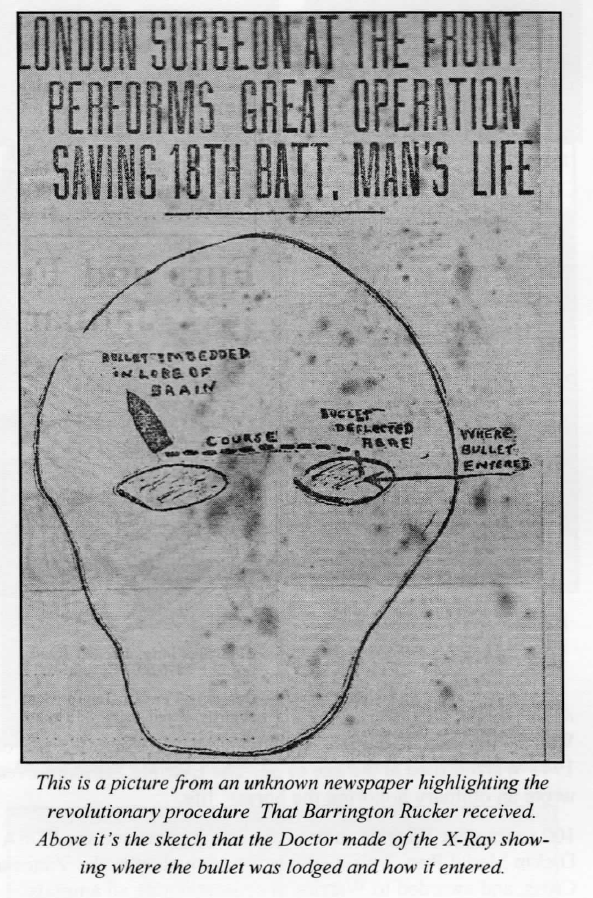
The letter further states the operation was “four days ago” and that Rucker is putting up “a very brave fight” and his case is not “hopeless.”
“At times he is quite rational, and is always well behaved, but naturally, in his condition, his mind wanders to other things and places and he does not quite realize where he is. He does not at any time complain of pain, and seems entirely free from consciousness of having any. He makes many and bright remarks to us, and sometimes hums a little tune to us.
Major Hunt is exceedingly interested in his condition and is doing all in his power for the boy, and is also getting many attention and care from the staff. Those of our patients who are up and about dance attendance on his every wish, and they too are exceeding fond of him. He is quite the ‘pet’ of our ward of sixty patients, and I am sure you would feel satisfied that everything is being done to aid his recovery. I might mention, incidentally, that his appetite is excellent, so he is able and willing to take many nourishing things.
Trusting that we shall be able to give a report of “greatly improved” before long. Very sincerely, your nursing sister,
On January 14, 1916 the Fort William Daily Times Journal reported that a doctor from that community, Dr. John G. Hunt[xi], performed an operation on a Private Rucker that removed a bullet lodged in his brain, and he was able to regain “health after remarkable operation.”
Obviously, this was not the case. Though it is not clear from his medical records if he had more than one surgery, it appears that it was determined to send Rucker to England for more comprehensive treatment than they could have offered in France as it is noted on his chart he was to embark on the a hospital ship at 9:00 AM 19 November 1915 but that decision was reversed and a notation was made that an operation was made the next day. His chart shows a rising fever and after the operation the chart is silent with no entries for the next 8-days. His chart begins to record his basic condition until the day before his death when his temperature begins to rise to over 103 degrees F. and he dies of his wounds at 10:30 AM on 4 December 1915 after a valiant but hopeless struggle to survive. He appears to be relatively well eating solid food until 29 November and then there are no notes of him consuming solid food a nourishment.
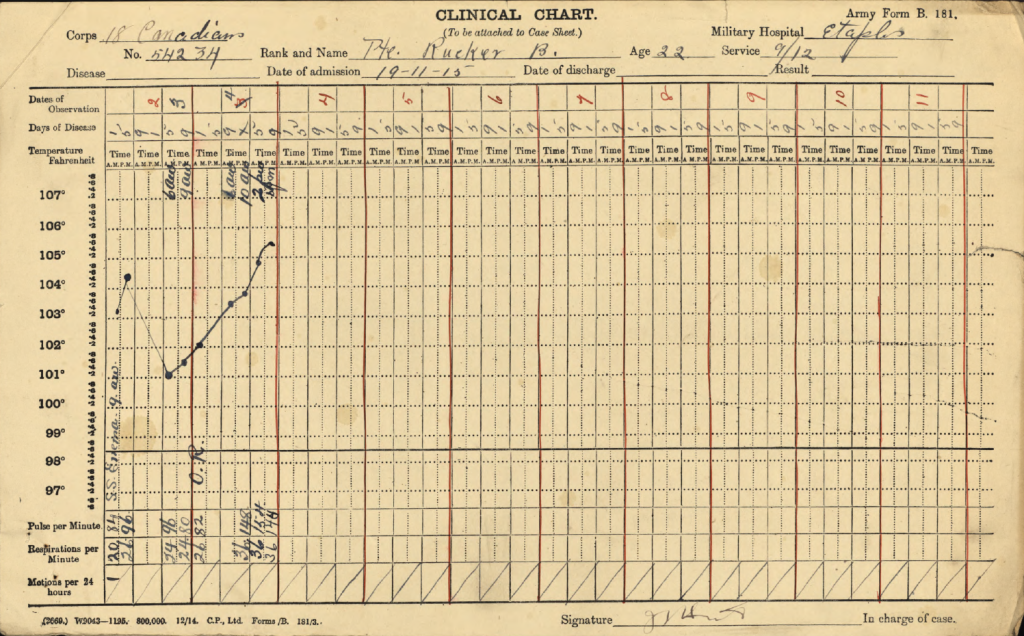
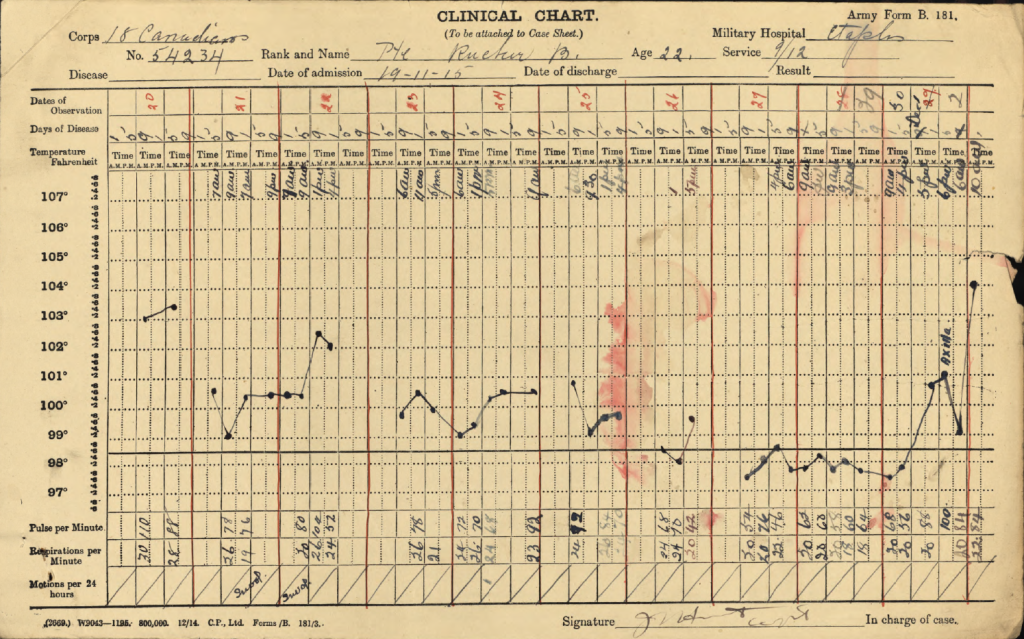
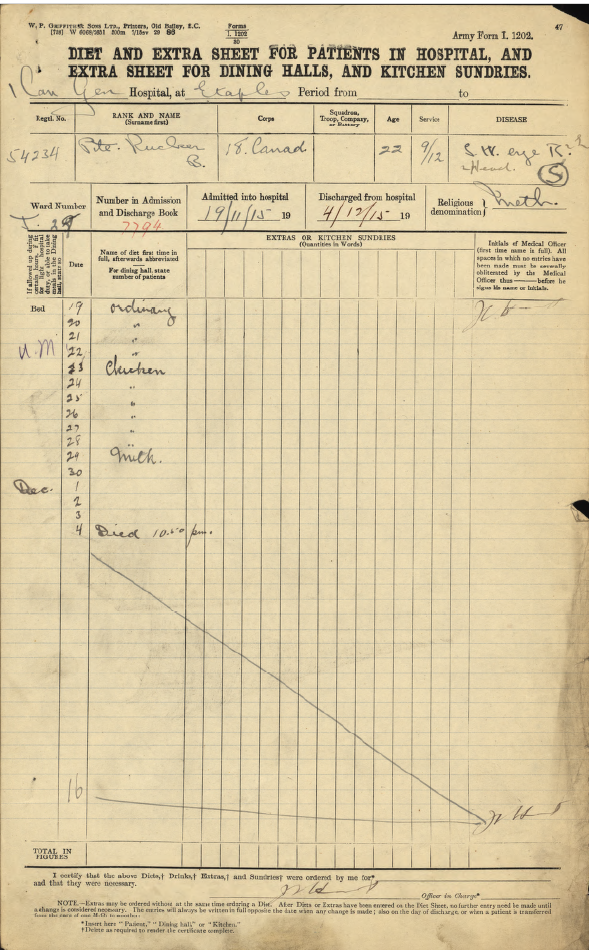

Aftermath
Private Barrington Ambrose Rucker did not die alone. No record has been found about his funeral details but he, as well as six other Imperial soldiers died that day who were buried at the Etaples Military Cemetery. He is one of 18 men of the 18th Battalion to be buried there along with over 11,000 other men and women.
His Battalion would have been informed and Captain Hale would be disheartened to learn of his best stretcher-bearer’s demise. Other members of this unit would take a moment to recognize their loss and move on to the more pressing issues of surviving combat.
His parents, perhaps proud while fighting the remorse of their 22-year-old son’s death and the loss to his family. The were a large family with nine children and Ambrose was the first to die which would have been heavy felt by his siblings.
The contemporary news clippings of the time recount with some fondness about his passing and it appears that his family connect through his paternal grandfather, a well-known judge, and his father, with a similar legal reputation makes him subject of some interest to the newspapers.
The 12 December 1915 Roanoke Times of Roanoke, Virginia records that a memorial service for Private Rucker will be held that Sunday. One suspects the service was well attended.
Rucker’s short life is full of empty spaces. We know not his motivations and what led to the apparent confusion of his movements when he left Vanderbilt University.
We do know that he was highly regarded by his officer he had the closest connection with, the medical officer on the 18th Battalion. It is his words that pull the measure of this young man and the fact Captain Hale wrote them, effectively, at Rucker’s feet as he lay in a stretcher waiting to be transported for further medical treatment. Hale does not mince his words. He directly states his expectation while offering some hope to the parents.
The nursing sister who followed up with the family seems a deeply empathetic soul. She writes words of comfort by showing that he is being cared for by a nurse, but is engaged and being encouraged and supported by his ward mates. His presence is felt and appreciated by those that are with him and he is cared for and is in the company of those who have experienced war and wounds and have compassion for their fellow man, who may have a short time to live. She offers a guarded hope in her letter. Perhaps because she is a nurse and not a doctor.
Close
A previous article explored this man (2 April 2021) but with the availability of new resources, a further look into the life of Private Rucker required a return to find out more about this man. New information allowed us to see more context of this man’s life and contribution to the Canadian war effort.
The news articles from the town and city newspapers of Virginia were critical to filling in the blanks and allowed the connection to be made between Rucker and Vanderbilt University, whose paper, The Hustler, had several references about him.
Without these resources the first article would stand and acknowledges the man but not as completely as this article does.
I only wish I could do Rucker, and by extension, his family a greater service in this attempt to put his life and sacrifice down on paper.
He is remembered better now, than before.
Sic semper tyrannis
[i] It was reported in the Evening Record that the “aeroplanes” reported were, in fact, 3 large “fireworks balloons” sent into the air at Morriston, New York as a joke. A subsequent report indicate that the Canadian authorities wound be investigating this matter further.
[ii] Richmond Times Dispatch. 28 November 1915. Page 60.
[iii] The News and Advance (Lynchburg, Virgina). 28 November 1915. Page 5.
[iv] The Vanderbilt Hustler. Mar. 1915. JSTOR, https://jstor.org/stable/community.34450340. Accessed 1 May 2024.
[v] Canada and the United States during wartime (no date) Canada and the United States during Wartime | News | From Vimy to Juno. Available at: https://www.vimytojuno.ca/en/news/canada-and-the-united-states-during-wartime#:~:text=Almost%20every%20battalion%20recruited%20during,of%20the%20Canadian%20Expeditionary%20Force. (Accessed: 30 April 2024).
[vi] The 18th Battalion was in Brigade Reserve at “Ridgewood”. The estimated distance between the front-line and the position is 2 kilometers.
[vii] Anti-Tetanus. A serum that helped prevent lockjaw.
[viii] Ibid. Page 21.
[ix] This is possibly Nursing Sister Gladys Iona Dixon. It may be possible that the transcription got this letter writer’s initials incorrect. From a review of the available nurses with the surname Dixon this nurse was working at No. 1 Canadian General Hospital.
[x] Bedford Museum and Genealogical Society. Barrington Rucker Winter Issue 2016. Page 20.
[xi] Major John Garnet Hunt, C.A.M.C. This man was an oculist who joined the 1st Contingent a Quebec, Quebec, on September 23, 1914. It is possible that this term refers to his specialty being related to the practice of ophthalmology. His next-of-kin on his attestation papers are from Port Arthur, Ontario.

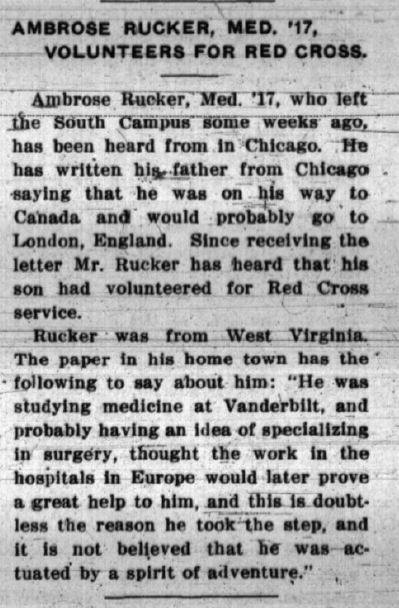
Leave a comment